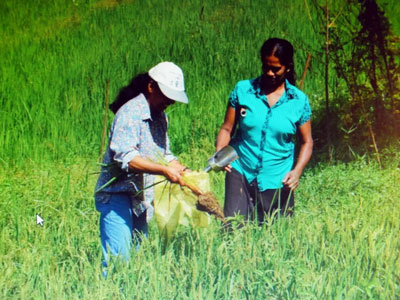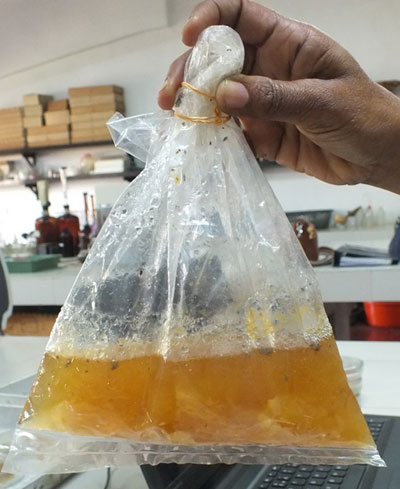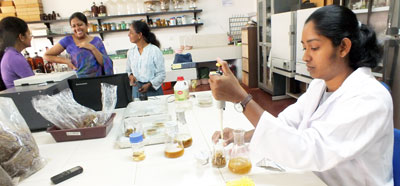Organic fertilizer via rice straw to boost rice production
The survival of all beings mostly depends on agriculture, crops and its sustainability due to the application of fertilizer. A growing issue today is that fertilizer contains chemicals that are harmful and with this information, there are efforts to develop organic fertilizer without or with minimal chemicals.

Prof. Chandi Rajapakse examines paddy plants in a paddy field
Rice is consumed by a large number of people in the world and likewise Sri Lanka’s main stable food is rice along with coconut and jackfruit. In the application of manure on paddy and other crops there has been extensive research carried out whether to apply the same manure or to develop new varieties with no chemicals.
In paddy cultivation fertilizer a definite turning point has been reached by a university professor at the Soil Science Department, Peradeniya University, which is called “Microbial Inoculants for composting of rice straw and promoting its use in the rice cropping system”. It has been invented after strenuous and long field and lab research which is now patented. The product is now successfully applied to paddy fields in the country while campaigns are under way to popularize it with awareness.
The inventor is Prof (Ms.) Chandi Rajapakse, Professor of Soil Science, Department of Soil Science, Faculty of Agriculture, Peradeniya University.
To ensure the success of this unique product – unique as it is organic and without chemicals – the National Science Foundation (NSF) has awarded a grant of around Rs.1.5 million under its Technological Grant scheme. The Business Times Team (BT) along with two NSF Scientific Officers – Dr. Priyanwada Warakagoda and Ms. Iresha Wijerathna, last week travelled to Peradeniya to obtain details about this unique achievement.
Stagnant rice yields
In the morning hours, the group reached the Peradeniya University premises and Prof. Rajapakse greeted the group and ushered them into the Soil Science Department lab. On the lab table there was an array of small glass containers with rice straw at various stages of experiments.
Prof. Rajapakse showed the group the final product. She indicated that during 1980s there was rice yield stagnation which pointed to a decline in fertility of rice soils and to improve the soil fertility the Department of Agriculture has recommended organic matter to be introduced to the paddy fields not only as a source of carbon but also as a source of potassium and nitrogen, particularly recycled rice straw which is widely available.
Dr. Warakagoda said that the NSF considered awarding the grant as scaling up production of microbial inoculants for composting of rice straw and promoting its use in rice cropping systems would address the issues in paddy cultivation such as continuous application of chemical fertilizers, reduction of soil fertility and high yields by farmers in paddy cultivation.

The final product of Rice Straw Fertilizer that would be dispatched to the paddy fields for application
She said that the project links with national requirements of introducing “grow green” technologies and promotes organic agriculture minimizing agrochemical based adverse health hazards. The ultimate project output is aimed at rapid microbial decomposition of rice straw in order to improve soil texture and soil fertility in paddy fields.
Prof. Rajapakse reminiscing the long history of the ‘Rice straw decomposition project’ said that the idea to work on such a project was given to her by a former director general of Agriculture, Department of Agriculture – Dr. S.L. Amarasiri where he too has been involved in research on rice straw and he has shown the benefit to the farmers.
She said that she obtained her BSc in 1989 and MPhil in 1997 from Peradeniya University and then proceeded to Canada and completed her PhD in the Saskatchewan University which has a leading Soil Science Department. There she was exposed to Canadian agriculture and was doing research on wheat.
Even when she was an undergraduate, she said that she has chosen to specialise on microbiology and in Canada she was more involved in the research on urea and ammonium sulfate in wheat fields.
In Sri Lanka she embarked on her project in 2003 and said that the reason to produce this kind of inoculant is that there is a large amount of rice straw produced during every paddy cultivation season which contains very important nutrient necessary for rice crop.
Those farmers who use combine-harvesters, though the raw straw is left in the field itself it would take some time to decompose and when the field is processed for the next season sometimes straw would get entangled in the wheels of the tractors used, she pointed out.
She said that in the case of farmers who do harvesting manually, they are reluctant to bring back the straw from the threshing floor. But once the straw is scientifically processed and produced in condensed form they can be easily applied in the field, Prof. Rajapakse pointed out.
Yellowing of crop
Sometimes farmers are reluctant to use raw straw because they have observed yellowing of the crop within a short time of planting because she said that it would be due to limited availability of nitrogen. So, she said that her invention addresses two issues – enhance or fast decomposition and the other is to provide additional amount of nitrogen for the crop.
Showing the final product to the group, Prof. Rajapakse said that the inoculant is produced by isolating bacteria and fungi from rice straw undergoing decomposition in the field. She said: “We go to the field, collect rice straw at different decomposition stages, bring them back to the lab and then isolate them using laboratory growth media”.

One of the Soil Science undergraduates tests the Rice Straw Fertilizer in the lab while at far left Prof. Rajapakse discusses the issues with the two NSF Scientific Officers
She said that field trials were made in such areas as Polonnaruwa, Ampara, Gampola, Mahailuppallama, Samanthurai and many other places and in some cases Prof. Rajapakse was herself in the field.
Given the present situation in the paddy cultivation the product is unique in that it contains less chemicals and the application would increase the crop. She said: “With more and more awareness campaigns the product would embrace the entire paddy cultivation in the country”.
Before the group left the Soil Science Lab, Prof. Rajapakse invited the group saying: “Come we will have some ice-cream, made by us” and led the group to the nearby university cafeteria.


